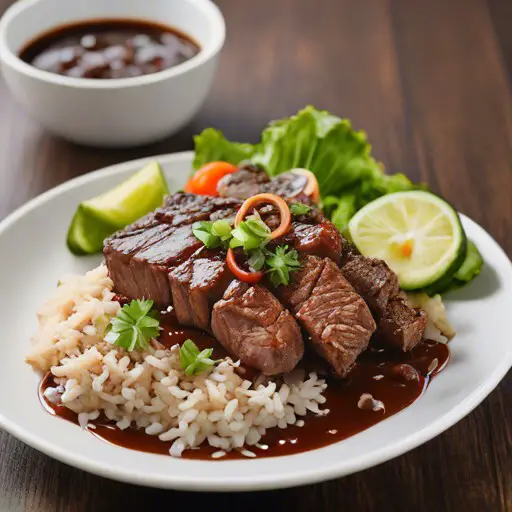Savoring Tradition: Mastering the Art of Bistek (Filipino Beef Steak)
Embark on a culinary journey through the rich and savory flavors of Filipino cuisine with Bistek, a timeless dish that encapsulates the essence of family gatherings and festive feasts. Join us as we unravel the secrets to creating the perfect Bistek—a symphony of tender beef, tangy citrus, and savory soy sauce that promises to transport your taste buds to the heart of the Philippines.
Ingredients:
For Bistek:
- 1.5 lbs beef sirloin or flank steak, thinly sliced
- 1/2 cup soy sauce
- 1/4 cup calamansi or lemon juice
- 1 large onion, thinly sliced into rings
- 4 cloves garlic, minced
- 1 teaspoon peppercorns, crushed
- 2 tablespoons vegetable oil
- 1 cup beef broth
- 2 tablespoons sugar
- Salt and pepper to taste
Instructions:
1. Marinating the Beef:
- In a bowl, combine the thinly sliced beef, soy sauce, calamansi or lemon juice, minced garlic, and crushed peppercorns. Allow it to marinate for at least 30 minutes.
2. Searing the Beef:
- Heat vegetable oil in a pan over medium-high heat. Sear the marinated beef slices until browned. Set aside.
3. Sautéing Onions:
- In the same pan, sauté the thinly sliced onion rings until they become translucent.
4. Deglazing with Broth:
- Pour in the beef broth to deglaze the pan, scraping up any flavorful bits from the bottom.
5. Simmering the Bistek:
- Return the seared beef to the pan. Add sugar and season with salt and pepper. Simmer until the beef is tender and the sauce has thickened.
6. Finishing Touch:
- Adjust the seasoning if needed. Serve the Bistek over steamed rice, and drizzle with the savory sauce.
Cook Notes and Variations:
- Pineapple Pleasure: Add pineapple chunks during the simmering stage for a sweet and tropical twist.
- Garlic Galore: Increase the amount of garlic for an extra punch of flavor.
- Vinegar Variation: Some variations include a splash of vinegar for an added tangy kick.
Keto and Low Carb Versions:
Keto Bistek:
- Substitute soy sauce with tamari or coconut aminos to reduce carb content.
- Omit sugar or replace it with a keto-friendly sweetener.
Low Carb Bistek:
- Opt for a low-carb soy sauce alternative.
- Use a sugar substitute or reduce the amount of sugar in the recipe.
Frequently Asked Questions (FAQs):
Q: Can I use a different cut of beef for Bistek? A: Absolutely! While sirloin or flank steak is commonly used, you can choose cuts like round steak or even tenderloin according to your preference.
Q: What’s the difference between calamansi and lemon? A: Calamansi is a Filipino citrus fruit with a unique flavor profile. If unavailable, lemon serves as a suitable substitute, providing a citrusy zing to the dish.
Q: Can I prepare Bistek in advance? A: Yes, Bistek often tastes even better after marinating for a longer period. You can marinate the beef overnight for intensified flavors.
Q: Is Bistek a sweet or savory dish? A: Bistek strikes a balance between savory and slightly sweet, thanks to the soy sauce and a hint of sugar. Adjust the sugar level according to your taste preference.
Q: What side dishes pair well with Bistek? A: Bistek complements well with steamed rice, garlic fried rice, or even a side of sautéed vegetables.
Preserving Flavors, Creating Memories
In conclusion, Bistek embodies the heart and soul of Filipino cooking—a delightful blend of savory, citrusy, and umami notes that leave a lasting impression. Whether you follow the classic recipe or venture into keto and low-carb adaptations, this dish serves as a testament to the diversity and richness of Filipino cuisine. So, gather your ingredients, embrace the marinade, and savor the culinary journey of Bistek—a dish that not only fills your plate but also creates memories around the table. Happy cooking!

